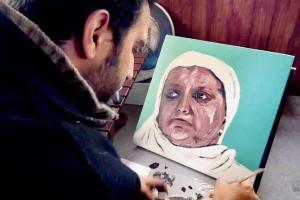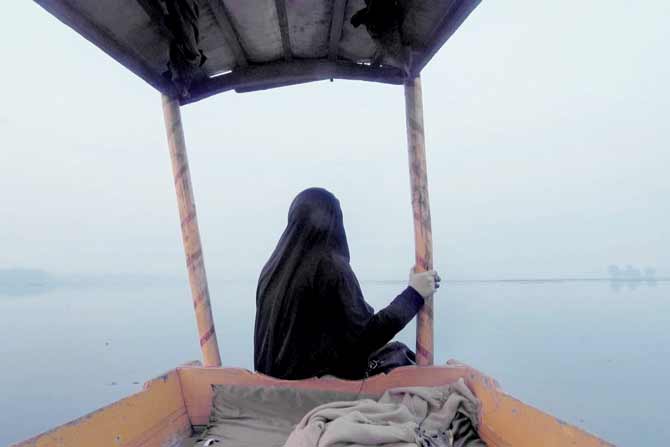A new documentary, set in Srinagar, features four Kashmiris who make art to inform as well as resist

Artist Mujtaba Rizvi making a portrait of Parveena Ahanger, who heads the Association of Parents of Disappeared Persons in Kashmir. Pic credit/Azaan Shah
A couple of years ago, Mumbai-based filmmakers Niyantha Shekar and Mukti Krishan were keen on making an independent documentary. Just when they were looking at the right story to explore, the duo stumbled upon 26-year-old Hina Arif's Instagram account. Arif, who landed in Delhi for studies, uses art to highlight human suffering in the active conflict zone of Kashmir, her home. "Arif spoke about the power of art to inform and resist. The initial plan was to make a short profile documentary on Arif, but as we did more research and met artistes in Kashmir, we decided to make a larger piece incorporating multiple voices on what it means to make art in the most militarised region in the world," Shekar tells us.

Mukti Krishan and Niyantha Shekar
ADVERTISEMENT
So in September 2017, Shekar and Krishan began shooting in Srinagar for their first project together, Raqs-e-Inquilab (Art in a Time of Conflict). The 28-minute documentary interweaves the personal narratives of four Kashmiri artistes. Their individual traumas are unique but what connects them is their pursuit to process this splintered world through unfiltered artistic expression. "We felt it was important to tell the stories of these artistes, share what they've been through, and talk about how the art that they create is essential to how they process their traumas," adds 30-year-old Shekar, whose previous documentary Baraf, that captures a day in the life of Mumbai's ice haulers, was selected by National Geographic for their Short Film Showcase.
In the film, produced and directed by Shekar and Krishan, Arif says, "When people accuse me of being a traitor, and call me an anti-national, I tell them main traitor nahin hoon. This is what I've seen, and now I want you to know (through art)." After the film premiered at the South Asian Short Film Festival in Kolkata in March this year, it was released on YouTube just a few days before Article 370 was revoked. But this was no coincidence, Shekar says, adding, "We had no idea that such a decision was in the works. Our hope was always that our characters inspire more kindness and empathy in people. And it's critical, now more than ever, that people show compassion and the courage to stand for the rights of the people of Kashmir in the wake of this undemocratic move."
 Artist Hina Arif at Dal Lake in a still from the film. Pic Credit/Anirudh Ganapathy
Artist Hina Arif at Dal Lake in a still from the film. Pic Credit/Anirudh Ganapathy
When asked if the duo faced any challenges while making the film in Srinagar, 34-year-old Krishan tells us, "We didn't face any challenges other than the classic documentary filmmaking nightmares like characters backing out, locations not working out, the weather, etc. It was more to do with getting the editing and the story right—we had to make sure we were true to the stories we heard, we wanted to make the audience feel what we felt in a way that was authentic, and not manipulative."
While the film's three characters—Syed Mujtaba Rizvi, Hina Arif and Zeeshan Jaipuri—are children of the conflict, the fourth character, renowned painter and art teacher Masood Hussain, grew up in a time of relative peace before becoming witness to Kashmir's tragic transformation. "Hussain is a remarkable, prolific artist whose watercolour paintings of Srinagar and rural Kashmir represent what a more peaceful Kashmir looked like. And in the film, when he talks about what his childhood was like, there's an unmistakable joy that he exudes as he reminisces about the calm alleys of downtown Srinagar and how freely he and his friends used to roam," Shekar shares.
But this is no longer the Kashmir of his childhood, and his own children have grown up in an environment of conflict. Shekar continues, "They've seen militants being killed on the road just outside their own home. Hussain believes that his role as an artist is to witness and record history. And that's what he's done. His best works include his interpretation of a series of Agha Shahid Ali's couplets, and his digital pieces to protest the Indian Army's use of pellet guns in Kashmir that have blinded children as young as four and five."
The film has now been acquired by Journeyman Pictures, a distributor and co-producer of provocative and original factual content. It will be available for public viewing on YouTube for only a month. "We didn't set out to make a film with a message but if we are able to evoke compassion and empathy through our work, our job is done as filmmakers," Krishan concludes.
Catch up on all the latest Crime, National, International and Hatke news here. Also download the new mid-day Android and iOS apps to get latest updates
 Subscribe today by clicking the link and stay updated with the latest news!" Click here!
Subscribe today by clicking the link and stay updated with the latest news!" Click here!







